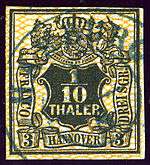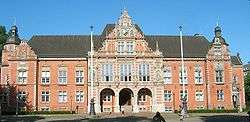Harburg (quarter)
| Harburg | |
|---|---|
| Quarter of Hamburg | |
|
The town hall | |
 Harburg | |
Location of Harburg in the city of Hamburg  | |
| Coordinates: 53°28′00″N 09°59′00″E / 53.46667°N 9.98333°ECoordinates: 53°28′00″N 09°59′00″E / 53.46667°N 9.98333°E | |
| Country | Germany |
| State | Hamburg |
| City | Hamburg |
| Borough | Harburg |
| Area | |
| • Total | 3.9 km2 (1.5 sq mi) |
| Population (31 December 2006) | |
| • Total | 21,193 |
| • Density | 5,400/km2 (14,000/sq mi) |
| Time zone | CET/CEST (UTC+1/+2) |
| Dialling codes | 040 |
| Vehicle registration | HH |
Harburg (Northern Low Saxon: Horborg) is a quarter (Stadtteil) in the homonymous borough (Bezirk) of Hamburg, Germany. It used to be the capital of the district in Lower Saxony. In 2006, the population was 21,193.
History
A castle named Horeburg, meaning swamp castle, was probably erected by the counts of Stade, to secure the eastern border of the county. The oldest records mentioning the castle date back to 1133 and 1137. Outside the castle a settlement developed. As to religion Harburg belonged to the Diocese of Verden (till 1648). In 1257 the area became part of the Duchy of Brunswick and Lunenburg. After its dynastic partition in 1267 Harburg was part of the Brunswick-Lunenburgian Principality of Lunenburg (Celle). In 1288 the settlement outside the castle was granted municipal rights and in 1297 town privileges. The town was then the centre of the Bailiwick of Harburg (Vogtei Harburg).
After Duke Otto (1495–1549), who co-ruled Lunenburg-Celle with his brother Duke Ernest I the Confessor, had married a woman unconformable to his rank, he was urged to retire from co-ruling the principality in 1527. Otto could reach an agreement, allowing him and his family to live in Harburg castle and to rule his own precinct, the Bailiwick of Harburg, however, as a subfief of Lunenburg-Celle. Thus Harburg became the capital of the Principality of Harburg, which continued to exist under Otto's son, Duke Otto II of Harburg (1528–1603) and grandson Duke William Augustus (1564–1642). With the latter's death the Brunswick-Lunenburgian branch of Harburg was extinct in the male line and the area reunited with Lunenburg-Celle proper.
In 1705 the Lunenburg-Celle line was extinct and the principality inherited by Duke George Louis of Brunswick and Lunenburg (Calenberg), ruling the Principality of Calenberg, which managed to be upgraded as Electorate of Brunswick and Lunenburg, colloquially named after its capital Electorate of Hanover, in 1708. In 1714 Prince-Elector George Louis ascended the British throne as George I, ruling Hanover and Britain in personal union.

During the Great French War Harburg suffered changing conquests, liberations and occupations, until it was first annexed by Westphalia (1807), only to be annexed by France in 1810. Harburg then became the capital of the Canton d'Harbourg within the Arrondissement de Lunebourg of the Département des Bouches-de-l'Elbe. After the French defeat in 1813 Harburg returned to Hanover, which was upgraded to the Kingdom of Hanover in 1814. The Hanoveran-British personal union ended in 1837. Hanover, including Harburg, was defeated and annexed by Prussia in 1866, joining united Germany in 1871. Since the 19th century the town has been distinguished as Harburg upon Elbe (Harburg an der Elbe or Harburg/Elbe) from the homonymous town in Bavaria.
With the defeat of Germany and the abdication of the monarchs in Germany in 1918, Prussia adopted a democratic government as a German state and was formally named Free State of Prussia. In 1927 Harburg/Elbe merged with Wilhelmsburg into Harburg-Wilhelmsburg. On 1 April 1937 Harburg-Wilhelmsburg was disentangled from Prussia – according to the "Greater Hamburg Act" – and ceded to the state of Hamburg, which on 1 April 1938 incorporated the city into a unitary city state municipality (Einheitsgemeinde), thus abolishing Harburg(-Wilhelmsburg)'s municipal independence dating back to 1288.
Geography
In 2006 according to the statistical office of Hamburg and Schleswig-Holstein, the quarter had an area of 3.9 km2 (1.5 sq mi). Harburg, situated in the southern side of Hamburg, borders with the quarters of Neuland, Gut Moor, Rönneburg, Wilstorf, Eißendorf, Heimfeld and Wilhelmsburg (in the district of Mitte). From this one it is physically separated by the river Elbe.
Demographics
The population of Harburg in 2006 was 21,193. The population density was 5,500/km2 (14,000/sq mi). 14.3% were children under the age of 18, and 14.1% were 65 years of age or older. 31.3% were immigrants. 1,619 people were registered as unemployed.[1] In 1999 there were 11,668 households out of which 16% had children under the age of 18 living with them and 55% of all households were made up of individuals. The average household size was 1.76.[2]
Population by year[1]
| 1987 | 1988 | 1989 | 1990 | 1991 | 1992 | 1993 |
| 19,000 | 19,202 | 19,672 | 20,069 | 20,405 | 20,151 | 20,382 |
| 1994 | 1995 | 1996 | 1997 | 1998 | 1999 | 2000 |
| 20,430 | 20,513 | 20,373 | 20,282 | 20,126 | 19,988 | 20,085 |
| 2001 | 2002 | 2003 | 2004 | 2005 | 2006 |
| 20,195 | 20,241 | 20,550 | 20,852 | 20,899 | 21,193 |
In 2006 there were 6,738 criminal offences in the quarter (318 crimes per 1000 people).[3]
Education
The quarter has 3 elementary schools and 4 secondary schools in the Harburg quarter.[4]
Infrastructure
Health systems
In 2006, 154 physicians in private practice and 16 pharmacies were counted in the Harburg quarter.[4]
Transportation

The quarter is serviced by the rapid transit system of the city train with several stations. The Hamburg-Harburg railway station is also a station for long-distance passenger trains for the German railway company.
According to the Department of Motor Vehicles (Kraftfahrt-Bundesamt), 5,148 private cars were registered (246 cars/1000 people) in the quarter.[4]
See also
References
- 1 2 Residents registration office, source: statistical office Nord of Hamburg and Schleswig-Holstein (2006)
- ↑ Source: statistical office Nord of Hamburg and Schleswig-Holstein (1999)
- ↑ State Investigation Bureaux (Landeskriminalamt), source: statistical office Nord of Hamburg and Schleswig-Holstein (2006)
- 1 2 3 Source: statistical office Nord of Hamburg and Schleswig-Holstein (2006)
- General
- Statistical office Hamburg and Schleswig-Holstein Statistisches Amt für Hamburg und Schleswig-Holstein, official website (German)
External links
![]() Media related to Harburg at Wikimedia Commons
Media related to Harburg at Wikimedia Commons
